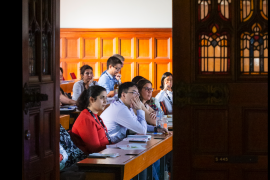The wider uptake of peer review of teaching has the potential to make a valuable contribution to the advancement of higher education — among its various benefits, peer review can play an important role in assisting individuals to enhance their teaching, in recognising and rewarding skills and achievements in teaching, and in developing individuals’ academic careers. The more widespread and systematic the use of peer review of teaching, the greater the opportunities to enhance the quality of teaching and learning in universities.
The DVC (Education) Portfolio has expanded the University-wide and centrally coordinated peer review program to support teaching development, building on the successful 2021 pilot and supporting similar approaches already in place in Faculties, Schools, and the University.
Read on to find out how you can sign up for a review.
Peer review for teaching – am I being judged?
Whether you are a new or experienced university educator, you can benefit from peer review for teaching (PRT). With a focus on effective teaching practice, the PRT program is open to all teaching staff at the University and is easily accessible through Module 12 of the University’s established Modular Professional Learning Framework (MPLF).
The PRT program aims to foster collegial and constructive feedback conversations around teaching delivery, unit design, learning materials, Canvas sites, assessment, and other elements as relevant.
What are the benefits?
PRT provides an opportunity to gain insight from other educators, learn more about pedagogical practice, and be reflective about how your students are learning and your own teaching practice. The process is a globally accepted and effective method for the professional development of university teachers.
There are a number of benefits to PRT reported in educational research:
- develops collegiality and cohesion,
- builds trust and increases confidence,
- creates transparency,
- raises the status of teaching, improving credibility and integrity,
- enhances teaching practice,
- improves student learning and student satisfaction,
- can be used to support tenure, promotion and re-appointment.
At Sydney, the PRT program is helpful if you are:
- seeking evidence for promotion, AP&D, or teaching award;
- seeking a ‘formal observation of teaching’ authentication of practice as part of the Sydney Educational Fellowship Program, Graduate Certificate in Educational Studies (Higher Education), or Sydney Professional Certificate (Foundations in Higher Education).
…I personally found it encouraging and motivating when the reviewers’ feedback validates some of my teaching practices. More importantly, my peers’ feedback and suggestions were helpful to both improve my teaching practices and also to identify my blind spots in teaching delivery.
feedback from Peer Review of Teaching participant (2021)
How does PRT work?
The peer review for teaching program includes 8 dimensions for review (see table below). Each reviewee can request a specific focus from their reviewer in the pre-review meeting.
Co-ordinated by the Educational Innovation team, a pool of expert reviewers are trained and ready to go. They will work with you to understand the context of your teaching they are reviewing and any areas you would like to focus on.
Once you sign-up (read on to find out how), each review follows a three-step process:
- A pre-meeting where the reviewer and reviewee connect to share relevant context and background of the teaching to be reviewed, and for the reviewee to share their objectives for the peer review process.
- The review is undertaken, utilising a standard proforma which focuses on the 8 teaching dimensions. It may take place in person or virtually, on a synchronous or asynchronous basis, depending on the objectives of the review.
- A post-review meeting, which includes reflection from the reviewee and feedback from the reviewer based on the pre-established objectives.
| # | Dimension |
|---|---|
| 1 | Explicit learning outcomes |
| 2 | Use of learning resources |
| 3 | Relevance to learners |
| 4 | Opportunities for learners to develop/expand their understanding |
| 5 | Encourages active learning behaviours |
| 6 | Teaching caters for learner diversity |
| 7 | Use of assessment strategies |
| 8 | The relational core |
How do I sign up for a review?
To participate and be matched with one of our expert reviewers, simply:
- enrol in the MPLF Canvas site: https://canvas.sydney.edu.au/enroll/MGEWBA and
- complete the application form on Module 12 Finding a Peer Reviewer page. Please note that reviewer availability may be limited depending on demand.
In addition to taking part in the peer review process, you may also be interested in completing Module 12 – Peer Review of Teaching of the MPLF. This will only take ~20-25 minutes of extra work asynchronously online.
Find out more
If you have any questions about the program, please contact us at [email protected]
Post last updated: 17 June 2024






2 Comments